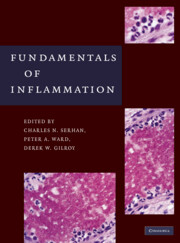Book contents
- Frontmatter
- Contents
- Contributors
- Preface
- PART I THE INFLAMMATORY RESPONSE – AN OVERVIEW
- PART II INDIVIDUAL CELL TYPES
- 4A Neutrophils I
- 4B Neutrophils II
- 5 Mast Cells as Sentinels of Inflammation
- 6 Basophils
- 7 Eosinophils
- 8 Macrophages
- 9 Lymphocytes
- 10 Fibroblasts and Stromal Cells
- 11 Neutrophil–Endothelial Cell Interactions
- PART III CHEMICAL MEDIATORS
- PART IV IMMUNOPHARMACOLOGY
- PART V INFLAMMATORY DISEASES/HISTOLOGY
- PART VI ANIMAL MODELS OF INFLAMMATION
- Index
- References
5 - Mast Cells as Sentinels of Inflammation
from PART II - INDIVIDUAL CELL TYPES
Published online by Cambridge University Press: 05 April 2014
- Frontmatter
- Contents
- Contributors
- Preface
- PART I THE INFLAMMATORY RESPONSE – AN OVERVIEW
- PART II INDIVIDUAL CELL TYPES
- 4A Neutrophils I
- 4B Neutrophils II
- 5 Mast Cells as Sentinels of Inflammation
- 6 Basophils
- 7 Eosinophils
- 8 Macrophages
- 9 Lymphocytes
- 10 Fibroblasts and Stromal Cells
- 11 Neutrophil–Endothelial Cell Interactions
- PART III CHEMICAL MEDIATORS
- PART IV IMMUNOPHARMACOLOGY
- PART V INFLAMMATORY DISEASES/HISTOLOGY
- PART VI ANIMAL MODELS OF INFLAMMATION
- Index
- References
Summary
INTRODUCTION
Mast cells are tissue-dwelling hematopoietic effector cells that are endowed with a range of potent inflammatory effector molecules. They are implicated in both allergic and nonallergic diseases, as well as in innate and adaptive immunity to infectious agents based on animal studies. Mast cells constitutively reside in a perivascular distribution in connective tissues and at mucosal surfaces (Figure 5.1). They are especially abundant in tissues that form interfaces with the external environment (skin, conjunctivae, intestinal, and airway mucosa), suggesting a strategic placement so as to function in a first line of host defense. Mast cells are best known for their role as effectors of classic type 1 hypersensitivity (allergic) reactions. In such reactions, mast cell activation is initiated by the binding of multivalent allergen to membrane-bound IgE that is coupled with the tetrameric high-affinity Fc receptor for IgE (FcεRI) on mast cells. IgE-dependent activation of mast cells results in their release of preformed inflammatory mediators that are stored in their secretory granules, including histamine, neutral proteases, preformed cytokines, and proteoglycans (Figure 5.2). In addition, activated mast cells secrete newly synthesized lipid mediators that are the products of endogenous arachidonic acid metabolism, such as prostaglandin (PG)D2, leukotriene (LT)B4, and LTC4, the parent molecule of the cysteinyl leukotrienes (cys-LTs).
Information
- Type
- Chapter
- Information
- Fundamentals of Inflammation , pp. 65 - 73Publisher: Cambridge University PressPrint publication year: 2010
